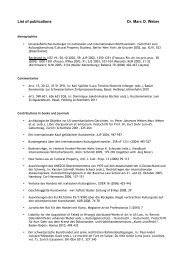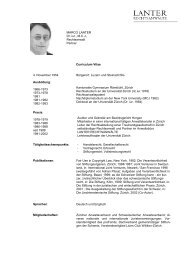Liability for the Acquisition of Faked or Wrongly Attributed Works of ...
Liability for the Acquisition of Faked or Wrongly Attributed Works of ...
Liability for the Acquisition of Faked or Wrongly Attributed Works of ...
Create successful ePaper yourself
Turn your PDF publications into a flip-book with our unique Google optimized e-Paper software.
w<strong>or</strong>k and include it in <strong>the</strong> Foundation’s Calder catalogue raisonné. Without <strong>the</strong><br />
au<strong>the</strong>ntication, <strong>the</strong> w<strong>or</strong>k was essentially unmarketable.<br />
Over <strong>the</strong> years, despite repeated requests, <strong>the</strong> Foundation refused without explanation<br />
to include <strong>the</strong> w<strong>or</strong>k in its catalogue raisonné. In response, in 2007,<br />
Thome brought an action in New Y<strong>or</strong>k state court seeking, among o<strong>the</strong>rs, (i) a<br />
mandat<strong>or</strong>y injunction compelling <strong>the</strong> w<strong>or</strong>k’s inclusion in <strong>the</strong> catalogue raisonné<br />
and (ii) a judgment declaring <strong>the</strong> w<strong>or</strong>k to be an au<strong>the</strong>ntic w<strong>or</strong>k by Calder.<br />
Judge Saxe dismissed <strong>the</strong> first claim stating that <strong>the</strong> courts may not “by mandat<strong>or</strong>y<br />
injunction affirmatively compel a private entity to include a particular<br />
w<strong>or</strong>k in its catalogue raisonné based solely on <strong>the</strong> court’s independent finding<br />
that <strong>the</strong> w<strong>or</strong>k is au<strong>the</strong>ntic” 45 and that nei<strong>the</strong>r <strong>the</strong> creation <strong>of</strong> such a catalogue n<strong>or</strong><br />
its inclusion <strong>or</strong> exclusion <strong>of</strong> particular w<strong>or</strong>ks “creates any legal entitlements <strong>or</strong><br />
obligations.” 46 In addition, he stated that <strong>the</strong> fact alone that <strong>the</strong> Calder Foundation<br />
has been accepted by <strong>the</strong> art w<strong>or</strong>ld as <strong>the</strong> body to create an auth<strong>or</strong>itative<br />
Calder catalogue raisonné “does not give a court <strong>the</strong> right to dictate what <strong>the</strong><br />
Foundation will include in that catalogue”. 47<br />
The second claim, i.e. <strong>the</strong> judicial declaration <strong>of</strong> <strong>the</strong> w<strong>or</strong>k to be an au<strong>the</strong>ntic<br />
w<strong>or</strong>k by Calder, was dismissed as well. Since “<strong>the</strong> courts are not equipped to deliver<br />
a meaningful declaration <strong>of</strong> au<strong>the</strong>nticity”, <strong>the</strong> plaintiff is not entitled to a<br />
declaration <strong>of</strong> au<strong>the</strong>nticity. 48 Finally, acc<strong>or</strong>ding to <strong>the</strong> appellate division <strong>of</strong> <strong>the</strong><br />
New Y<strong>or</strong>k Supreme Court, plaintiff failed in alleging that <strong>the</strong> cause <strong>of</strong> action was<br />
supp<strong>or</strong>ted by New Y<strong>or</strong>k antitrust law. 49<br />
44 The Calder Foundation was founded by Calder’s grandson, Alexander Rower, in 1987 at<br />
<strong>the</strong> age <strong>of</strong> 24; until today, <strong>the</strong> foundation has documented ca. 22’000 w<strong>or</strong>ks; see Clare<br />
Finn/Gilles Bensimon, Calder’s legacy, Apollo, November 2009, 54–58.<br />
45 Thome v. The Calder Foundation (supra note 43), 8.<br />
46 Id., 9.<br />
47 Id., 9–10.<br />
48 Id., 15, contrary and with reference to <strong>the</strong> French legal system. In France, declarations <strong>of</strong><br />
au<strong>the</strong>nticity are made by <strong>the</strong> courts. They appoint <strong>the</strong>ir own neutral judicial experts and<br />
put <strong>the</strong>m on a national list; see art. 2 loi no. 71-498 du 29 juin 1971 relative aux experts<br />
judiciaires, J.O. 30.6.1971, 6300 (modified by art. 47 loi no. 2004-130 du 11.2.2004, J.O.<br />
no. 36, 12.2.2004, 2847); as to <strong>the</strong> French judicial experts and <strong>the</strong>ir appointment, see Van<br />
Kirk Reeves, Establishing Au<strong>the</strong>nticity in French Law, in Spencer (supra note 11), 228–<br />
230 (227–234); Stéphanie Lequette-de Kervenoaël, L’au<strong>the</strong>nticité des œuvres d’art, Paris:<br />
L.G.D.J. 2006, no. 219.<br />
49 Thome v. The Calder Foundation (supra note 43), 32. Under <strong>the</strong> Donnelly Act (codified<br />
as NY Gen. Oblig. Law §§ 340 et seq.), plaintiff must (i) identify <strong>the</strong> relevant product<br />
market, (ii) allege a conspiracy between two <strong>or</strong> m<strong>or</strong>e entities and (iii) allege that <strong>the</strong> economic<br />
impact <strong>of</strong> that conspiracy was to restrain trade in <strong>the</strong> relevant market; see Newsday,<br />
Inc. v. Fantastic Mind, 237 AD2d 497 (1997). – In European law, defendant who refuses<br />
an expertise <strong>or</strong> refuses to include a particular w<strong>or</strong>k in <strong>the</strong> artist’s catalogue raisonné<br />
422





